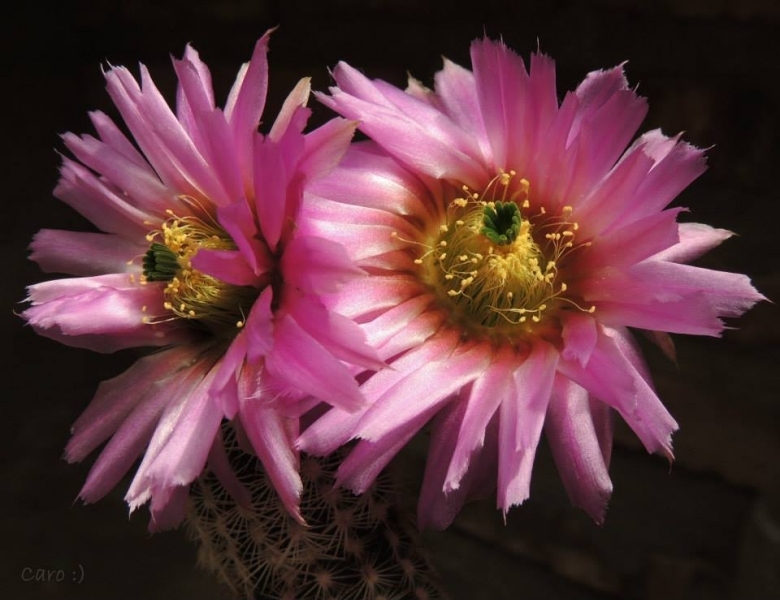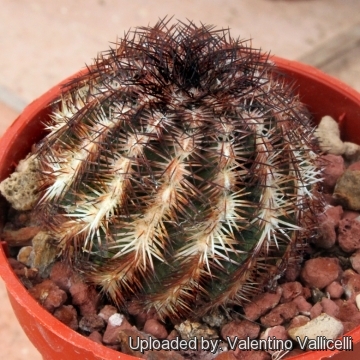Donate now to support the LLIFLE projects.
Your support is critical to our success.
Your support is critical to our success.
Accepted Scientific Name: Echinocereus reichenbachii subs. perbellus (Britton & Rose) N.P.Taylor
Cactaceae Consensus Init. 3: 9. 1997

Echinocereus perbellus (Echinocereus reichenbachii subs. perbellus) Photo by: Carolina González
Synonyms:
- Echinocereus reichenbachii subs. perbellus (Britton & Rose) N.P.Taylor
- Echinocereus perbellus Britton & Rose
- Echinocereus reichenbachii var. perbellus (Britton & Rose) L.D.Benson
See all synonyms of Echinocereus reichenbachii
back
Accepted name in llifle Database:Echinocereus reichenbachii (Terscheck ex Walp.) Haage jr. ex Britton & Rose
Cactaceae (Britton & Rose) 3: 25. 1922 [12 Oct 1922] ; vide Gray Herb. Card Cat
Synonymy: 38
- Echinocereus reichenbachii (Terscheck ex Walp.) Haage jr. ex Britton & Rose
- Cereus reichenbachianus Labour.
- Echinocactus reichenbachianus (Terscheck) Terscheck ex Fennel
- Echinocactus reichenbachii Terscheck ex Walp.
- Echinocereus caespitosus var. reichenbachii (Terscheck ex Walp.) Borg
- Echinocereus pectinatus var. reichenbachii (Terscheck ex Walp.) Werderm.
- Echinocereus reichenbachianus hort. ex Haage
- Echinopsis pectinata var. reichenbachiana (Terscheck) Salm-Dyck
- Echinopsis reichenbachiana Pfeiff. ex C.F.Först.
- Echinocereus caespitosus var. castaneus (Engelm.) Rümpler in Förster
- Cereus caespitosus var. castaneus Engelm. in A.Gray
- Cereus reichenbachianus var. castaneus Labour.
- Echinocereus caespitosus var. major (Engelm.) Rümpler in C.F.Först.
- Cereus caespitosus var. major Engelm.
- Echinocereus caespitosus var. minor (Engelm.)
- Cereus caespitosus var. minor Engelm.
- Echinocereus pailianus
- Echinocereus reichenbachii f. albispinus hort. non Lahman
- Echinocereus reichenbachii var. anigosanthus Y.Itô
- Echinocereus reichenbachii f. brevispinum hort.
- Echinocereus reichenbachii subs. burrensis G.Frank, Metorn & E.Scherer
- Echinocereus reichenbachii subs. caespitosus (Engelm.) W.Blum & Mich.Lange in W.Blum et al.
- Cereus caespitosus Engelm. & A.Gray
- Echinocereus caespitosus (Engelm.) Engelm. in Wisliz.
- Echinocereus pectinatus var. caespitosus (Engelm.) K.Schum.
- Echinocereus pectinatus f. caespitosus (Engelm.) Schelle
- Mammillaria caespitosa (Engelm.) A.Gray
- Echinocereus reichenbachii var. castaneus (Engelm.) nov. comb. ined.
- Echinocereus caespitosus f. castaneus (Engelm.) Borg
- Echinocereus castaneus (Engelm.) Orcutt
- Echinocereus reichenbachii subs. comanchensis D.Felix, Oldach & J.Oldach
- Echinocereus reichenbachii f. cristatus hort.
- Echinocereus reichenbachii var. purpureus (Lahman) D.Parker
- Echinocereus caespitosus var. purpureus (Lahman) D.Weniger
- Echinocereus purpureus Lahman
- Echinocereus rotatus Linke
- Echinocereus pectinatus var. rotatus (Linke) Linke ex Haage
- Echinocereus texensis Jacobi
Echinocereus reichenbachii var. albertii L.D.Benson
Cact. Succ. J. (Los Angeles) 41: 127. 1969
Synonymy: 2
- Echinocereus reichenbachii var. albertii L.D.Benson
- Echinocereus fitchii subs. albertii (L.D.Benson) W.Blum & Mich.Lange in W.Blum et al.
Echinocereus reichenbachii subs. armatus (Poselg. ex Engelm.) N.P.Taylor
Cactaceae Consensus Init. 3: 9. 1997
Synonymy: 8
- Echinocereus reichenbachii subs. armatus (Poselg. ex Engelm.) N.P.Taylor
- Cereus pectinatus var. armatus Poselg. ex Engelm.
- Echinocereus armatus (Poselg.) A.Berger
- Echinocereus caespitosus var. armatus (Poselg. ex Engelm.) Borg
- Echinocereus fitchii var. armatus
- Echinocereus reichenbachii var. armatus (Poselg. ex Engelm.) N.P.Taylor
- Echinocereus spinosus (J.M.Coult.) Borg
- Cereus pectinatus var. spinosus J.M.Coult.
Echinocereus reichenbachii subs. baileyi (Rose) N.P.Taylor
Cactaceae Consensus Init. 3:9. 1997
Synonymy: 13
- Echinocereus reichenbachii subs. baileyi (Rose) N.P.Taylor
- Echinocereus baileyi Rose
- Echinocereus reichenbachii var. baileyi (Rose) N.P.Taylor
- Echinocereus baileyi var. brunispinus Backeb.
- Echinocereus baileyi var. caespiticus Backeb.
- Echinocereus longispinus Lahman
- Echinocereus mariae Backeb.
- Echinocereus oklahomensis Lahman
- Echinocereus reichenbachii var. albispinus (Lahman) L.D.Benson
Echinocereus reichenbachii subs. fitchii (Britton & Rose) N.P.Taylor
Cactaceae Consensus Init. 3: 9. 1997
Synonymy: 4
- Echinocereus reichenbachii subs. fitchii (Britton & Rose) N.P.Taylor
- Echinocereus fitchii Britton & Rose
- Echinocereus reichenbachii var. fitchii (Britton & Rose) L.D.Benson
- Echinocereus melanocentrus J. Lowry
Echinocereus reichenbachii subs. perbellus (Britton & Rose) N.P.Taylor
Cactaceae Consensus Init. 3: 9. 1997
Synonymy: 3
- Echinocereus reichenbachii subs. perbellus (Britton & Rose) N.P.Taylor
- Echinocereus perbellus Britton & Rose
- Echinocereus reichenbachii var. perbellus (Britton & Rose) L.D.Benson
back

JRT111 Bent Co., CO, 1311m. A form with robust, fat stems, short tight spines and large magenta flowers (Echinocereus reichenbachii subs. perbellus) Photo by: Valentino Vallicelli
Send a photo of this plant.
The gallery now contains thousands of pictures, however it is possible to do even more. We are, of course, seeking photos of species not yet shown in the gallery but not only that, we are also looking for better pictures than those already present. Read More...
The gallery now contains thousands of pictures, however it is possible to do even more. We are, of course, seeking photos of species not yet shown in the gallery but not only that, we are also looking for better pictures than those already present. Read More...
| Your Actions | |
|---|---|
| Back to Echinocereus index | |
| Back to Cactaceae index | |
 |
Back to Cacti Encyclopedia index |









